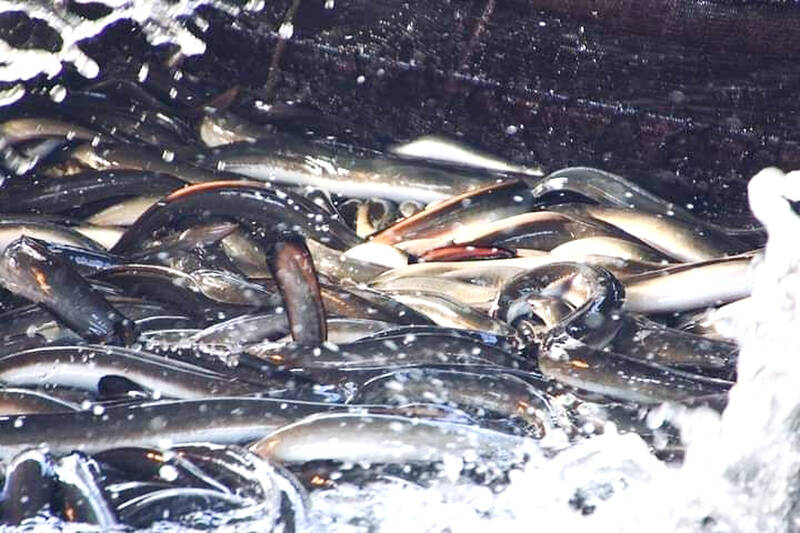Eel production in Taiwan has slipped behind that of other East Asian nations over the past few years, leaving producers looking for alternatives to the formerly lucrative export market.
Once the regional leader in eel production, Taiwan’s release of fry into farming ponds has fallen far behind Japan, China and South Korea.
Taiwan leads off eel harvest season in East Asia, which typically runs from Nov. 1 to the end of February the following year.

Photo : Tsai Tsung-hsun, Taipei Times
To supply Japan for “unagi day” in midsummer, eel fry must be released before the middle of January, making Taiwan the best place to supply its neighbor during the high season.
However, Japanese producers have in recent years begun purchasing eel fry from Taiwan at high prices to supply their domestic market, driving down Taiwan’s eel exports and breeding industry.
As a result, the market share of Taiwanese eel in Japan and the amount of fry released into farming ponds has been falling rapidly.
Taiwan only accounted for 1.2 percent of eel fry released in East Asia, at 320kg, the Nihon Yoshoku Shimbun, a Japanese trade journal focusing on the eel industry, reported on April 7.
Japan led the industry at 49.3 percent (13,553kg), followed by China at 32.7 percent (9,000kg) and South Korea at 16.9 percent (4,639kg).
Owing to China’s recent success in the industry, South Korea has begun importing significant quantities of fry from China and Hong Kong to boost its numbers, making Taiwan’s market share likely to fall below 1 percent, the publication said.
Taiwan’s eel exports had already begun to slide before the COVID-19 pandemic. Exports fell each year between 2018 and last year, from 2,396 tonnes to 1,654 tonnes during the period.
July was the most productive month each year, ranging from 182 tonnes in 2020 to 410 tonnes in 2018.
The worst hit to fry rearing came over the past two years, from 8,143.8kg in 2020 to 4,430.49kg in 2021, and only 877.33kg last year.
This year, only 320kg has been released.
Eel farming in Taiwan is being depressed by high fry prices and dwindling exports, Taiwan Association of Eel and Shrimp Production Cooperatives chairman Tang Ching-tsung (唐慶宗) said.
As the risk is high, farmers are reducing their stock, making their exports less competitive and continuing the downward cycle, Tang said.
The way to correct the problem is to keep harvested fry in Taiwan to replenish domestic farming ponds in preparation for Japan’s “unagi day,” he said.
Farmer Kuo Hung-yu (郭紘瑜) said that he used to frequently send large eel orders to Japan, but now only sends one or two containers at lower prices.
Most eel producers are waiting to see what might happen, Kuo said, adding that his strategy is to stabilize revenue by actively pursuing domestic buyers before seeking more export opportunities.
Farmer Tang Hsin-yuan (唐昕遠), who is newer to the business, agreed that fry are expensive and exporting to Japan is not cost-effective.
He is only rearing enough this year to satisfy domestic demand and is converting idle ponds to more competitive species.
Tang said that if he stuck with only rearing eel, there is a good chance he would lose money despite the great effort required.

Taiwan is to commence mass production of the Tien Kung (天弓, “Sky Bow”) III, IV and V missiles by the second quarter of this year if the legislature approves the government’s NT$1.25 trillion (US$39.78 billion) special defense budget, an official said yesterday. Commenting on condition of anonymity, a defense official with knowledge of the matter said that the advanced systems are expected to provide crucial capabilities against ballistic and cruise missiles for the proposed “T-Dome,” an advanced, multi-layered air defense network. The Tien Kung III is an air defense missile with a maximum interception altitude of 35km. The Tien Kung IV and V

The disruption of 941 flights in and out of Taiwan due to China’s large-scale military exercises was no accident, but rather the result of a “quasi-blockade” used to simulate creating the air and sea routes needed for an amphibious landing, a military expert said. The disruptions occurred on Tuesday and lasted about 10 hours as China conducted live-fire drills in the Taiwan Strait. The Civil Aviation Administration (CAA) said the exercises affected 857 international flights and 84 domestic flights, affecting more than 100,000 travelers. Su Tzu-yun (蘇紫雲), a research fellow at the government-sponsored Institute for National Defense and Security Research, said the air

A strong continental cold air mass is to bring pollutants to Taiwan from tomorrow, the Ministry of Environment said today, as it issued an “orange” air quality alert for most of the country. All of Taiwan except for Hualien and Taitung counties is to be under an “orange” air quality alert tomorrow, indicating air quality that is unhealthy for sensitive groups. In China, areas from Shandong to Shanghai have been enveloped in haze since Saturday, the ministry said in a news release. Yesterday, hourly concentrations of PM2.5 in these areas ranged from 65 to 160 micrograms per cubic meter (mg/m³), and pollutants were

Taiwan’s armed forces have established response protocols for a wide range of sudden contingencies, including the “Wan Chun Plan” to protect the head of state, the Ministry of Defense (MND) said today. After US President Donald Trump on Saturday launched a series of airstrikes in Venezuela and kidnapped Venezuelan President Nicolas Maduro, concerns have been raised as to whether China would launch a similar “decapitation strike” on Taiwan. The armed forces regularly coordinate with relevant agencies and practice drills to ensure preparedness for a wide range of scenarios, Vice Minister of National Defense Hsu Szu-chien (徐斯儉) told reporters before a